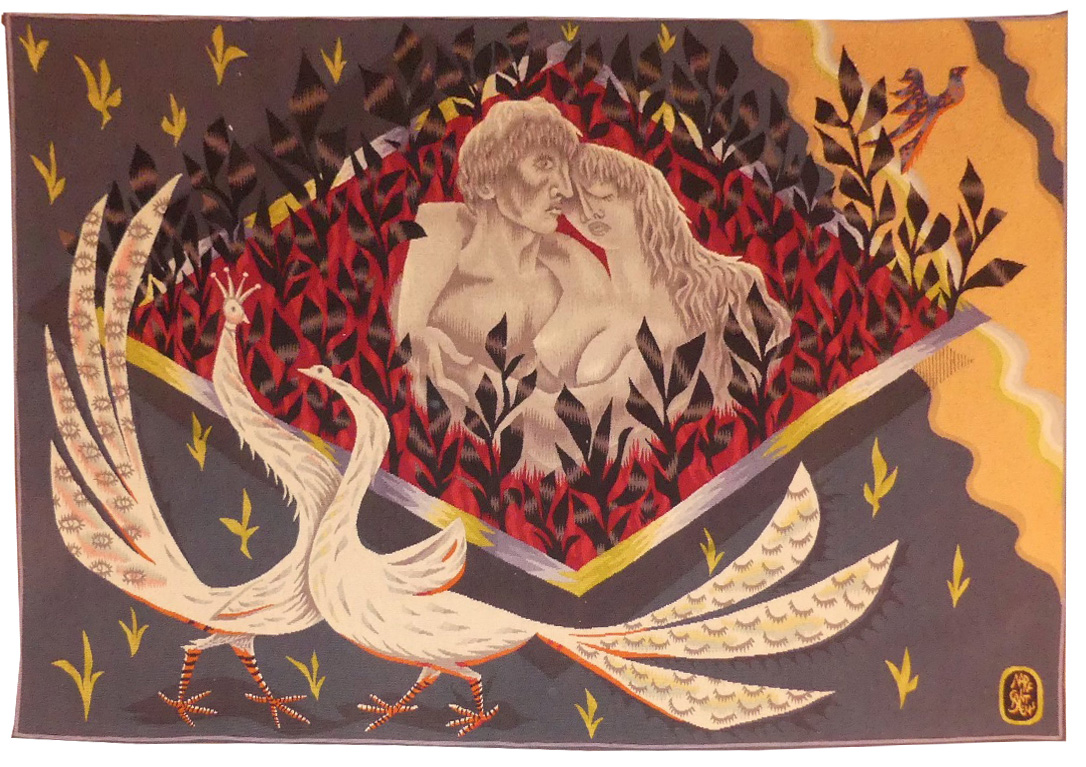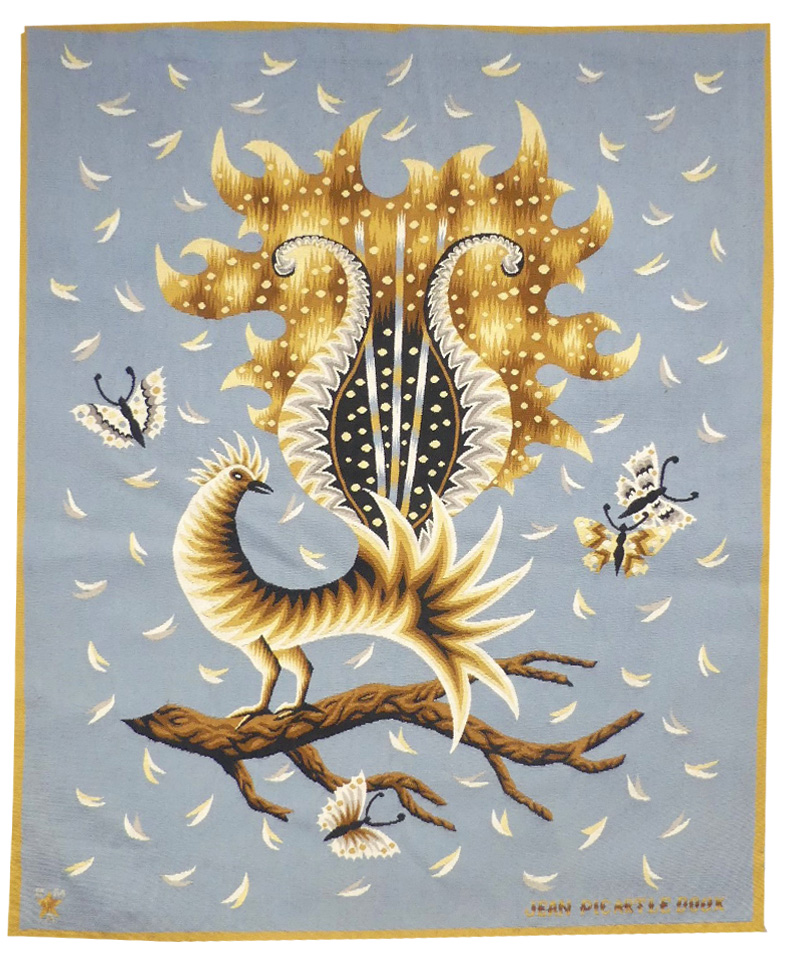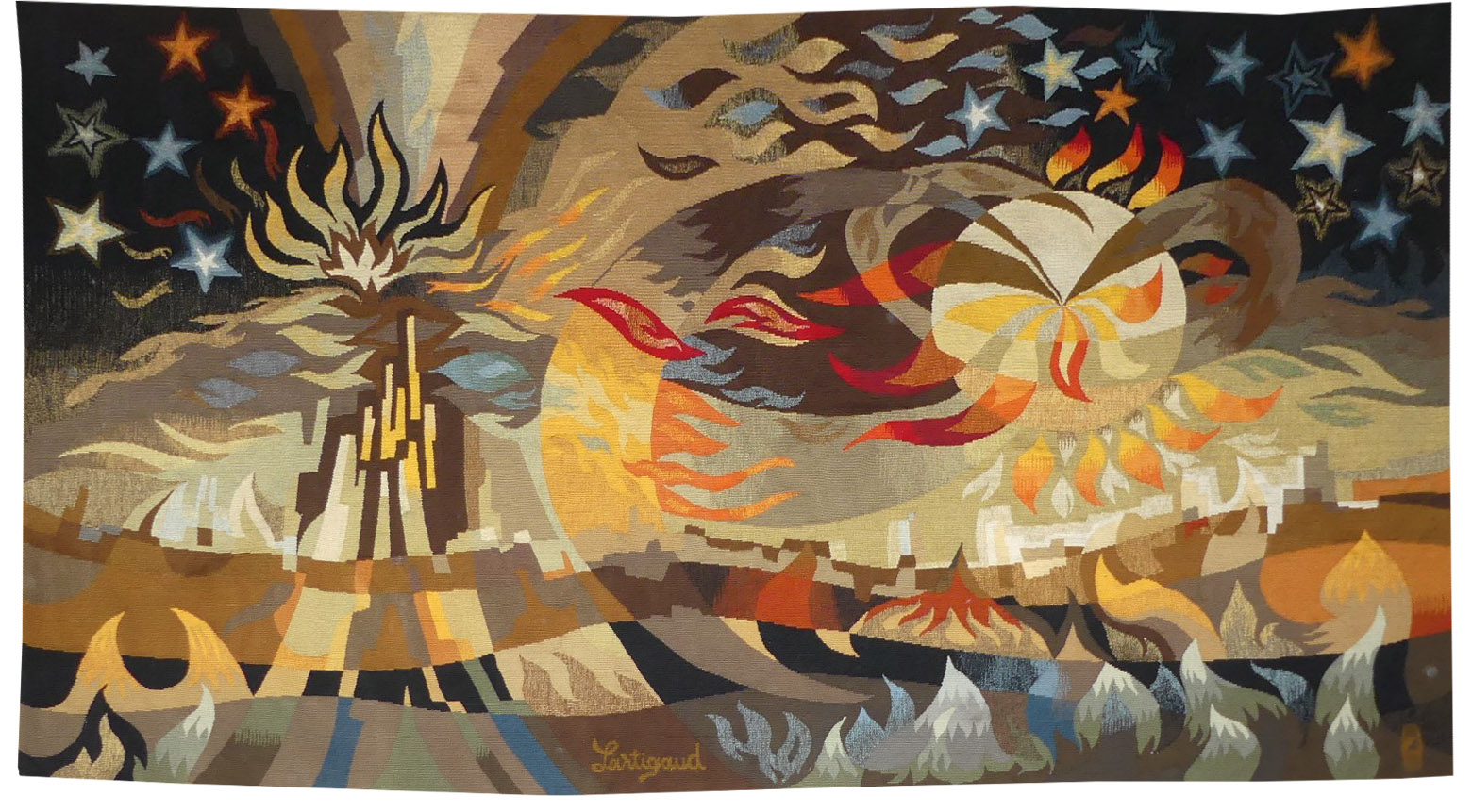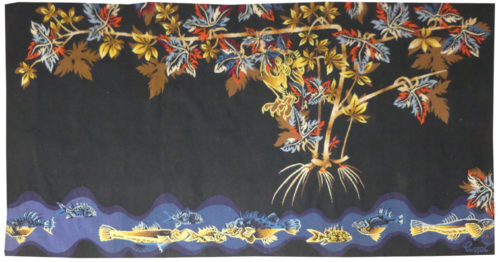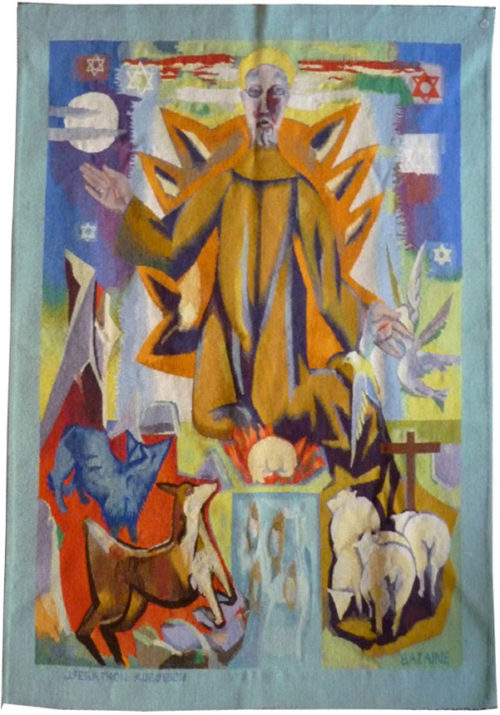-
L'oiseau flamme (the flame bird)
Aubusson tapestry woven by the Berthaut workshop. With signed label. Circa 1960. Jean Picart le Doux is one of the foremost figures in the renaissance of the art of tapestry. His earliest contributions to the field date back to 1943 when he designed cartoons for the passenger ship “la Marseillaise”. A close associate of Lurçat, whose theories he would adopt (limited palette, numbered cartoons...), he was a founding member of the A.P.C.T. (Association des Peintres-cartonniers de Tapisserie), and soon after, a teacher at the Ecole Nationale Supérieure des Arts Décoratifs. The state gave him several commissions most of them at the Aubusson workshop, and some at the Gobelins : the most spectacular of these being for the University of Caen, the Theatre in Le Mans, the passenger ship France or the Prefecture of the Creuse département ... In as much as Picart le Doux’s aesthetic is close to that of Lurçat, so also is his inspiration and his subject matter, although in a register which is more decorative than symbolic, where he brings together heavenly bodies (the sun, the moon, the stars...), the elements, nature (wheat, vines, fish, birds...), man, literary quotation ... This lyrebird motif dates from 1954 and is taken from a larger and richer design incorporating a garden « à la française ». Picart le Doux habitually recycled elements from earlier designs. Bibliography : Marthe Belle-Joufray, Jean Picart le Doux, Publications filmées d’art et d’histoire, 1966 Maurice Bruzeau, Jean Picart le Doux, Murs de soleil, Editions Cercle d’art, 1972 Exhibition Catalogue, Jean Picart le Doux, tapisseries, Musée de Saint-Denis, 1976 Exhibition Catalogue Jean Picart le Doux, Musée de la Poste, 1980 -
A former student at the ENAD in Aubusson, Lartigaud created his first tapestry cartoon in 1968. He went on to design hundreds more, most of them woven by the Four Workshop, in an abstract style occasionally studded with celestial bodies.Aubusson tapestry woven in the Four workshop. With label, n°EA. Circa 1970.
-
La chouette et l'étang (the owl and the pond)
Tapestry woven in the Simone André workshop. With signed label. Circa 1955.Lurçat’s artistic production was immense : it is however his role as the renovator of the art of tapestry design which ensures his lasting renown. As early as 1917, he started producing works on canvas, then in the 20’s and 30’s, he worked with Marie Cuttoli. His first collaboration with the Gobelins workshop dates back to 1937, at the same time he discovered the tapestry of the Apocalypse which was essential in his decision to devote himself to tapestry design. He first tackled the technical aspects with François Tabard, then on his installation at Aubusson during the war, he established his technique : broad point, a simplified palette, outlined cartoons with colours indicated by pre-ordained numbers. A huge production then follows (over 1000 cartoons) amplified by his desire to include his painter friends, the creation of the A.P.C.T. (Association des Peintres-Cartonniers de Tapisserie) and the collaboration with the art gallery La Demeure and Denise Majorel, and then by his role as a tireless advocate for the medium around the world. His tapestries reveal a pictorial world which is specifically decorative, with a very personal symbolic iconography : cosmogony (the sun, the planets, the zodiac, the four elements…) stylised vegetation, fauna (rams, cocks, butterflies, chimera …) standing out against a background without perspective (voluntarily different from painting) and, in his more ambitious work, designed as an invitation to share in a poetic (he sometimes weaves quotations into his tapestries) and philosophical (the grand themes are broached from the wartime period onwards) vision whose climax is the “Chant du Monde” (Song of the World) (Jean Lurçat Museum , ancien hôpital Saint Jean, Angers) which remained unfinished at his death. The owl, almost completely hidden by vegetation, is in apposition to the fish in the pond. The various worlds and elements evoked here : animal, vegetable, air and water...reflect on each other in a syncretism both harmonious and serene. Bibliography : Tapisseries de Jean Lurçat 1939-1957, Pierre Vorms Editeur, 1957 Exhibition Catalogue Lurçat, 10 ans après, Musée d’Art moderne de la ville de Paris, 1976 Exhibition catalogue Les domaines de Jean Lurçat, Angers, Musée Jean Lurçat et de la tapisserie contemporaine, 1986 Symposium Jean Lurçat et la renaissance de la tapisserie in Aubusson, Aubusson, Musée départemental de la tapisserie 1992 Exhibition Catalogue Dialogues avec Lurçat, Musées de Basse-Normandie, 1992 Exhibition catalogue Jean Lurçat, Donation Simone Lurçat, Académie des Beaux-Arts, 2004 Jean Lurçat, le chant du monde Angers 2007 Gérard Denizeau, Jean Lurçat, Liénart, 2013 Exhibition Catalogue Jean Lurçat, Meister der französischen Moderne, Halle, Kunsthalle Exhibition Catalogue Jean Lurçat au seul bruit du soleil, Paris, galerie des Gobelins, 2016 -
Saint François parlant aux animaux (St Francis talking to the animals)
Aubusson tapestry woven in the Perathon workshop. Circa 1940. Jean Bazaine, like many of his contemporaries, was a prolific mural artist particularly for large scale edifices. Although he is above all recognised as a designer of stained glass windows and mosaics, he was also making tapestry cartoons as early as the 1930’s. These pieces formed part of the renewal of religious art of which Bazaine would be one of the principal protagonists, particularly after the war. Jean Bazaine, in association with l’abbé Morel (one of those foremost in promoting the introduction of abstract art into churches), was at the head of a painters’ workshop from 1936 to 1937 hence, undoubtedly, the preoccupations which he had already voiced in the domain of religious art. This particular cartoon, figurative in character, (Bazaine would abandon figurative representation during the war period) employing traditional iconography, is thus a modest example of the artist’s first steps in both mural and religious art.


